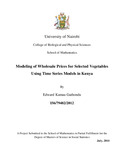| dc.description.abstract | Price forecasting is more sensitive with vegetable crops due to their highly nature of perishability
and seasonality and is often used to make better-informed decisions and to manage price
risk. Further, to improve domestic market potential for smallholder producers, who are the
biggest suppliers in the market and in line with the government‟s Agriculture Sector
Development Strategy (ASDS). Three autoregressive models are used to predict and model the
wholesale prices for selected vegetables in Kenya shillings per kilogram. The models are;
Autoregressive Moving Average (ARMA), Vector Autoregressive (VAR), Generalized
Autoregressive Condition Heterostadicity (GARCH) and the mixed model of ARMA and
GARCH. This time series data for tomato, potato, cabbages, kales and onions for markets in
Nairobi, Mombasa, Kisumu, Eldoret and Nakuru wholesale markets are considered as the
classical national average. The result indicates the models are valid in predicting. Based on the
model selection criterion the best forecasting models in ARIMA are; Potato ARIMA (1,1,0), Cabbages
ARIMA (2,1,2), tomato ARIMA (3,0,1), onions ARIMA (1,0,0), Kales ARIMA (1,1,0) . Further, the
mixed model of ARMA (1, 1) and GARCH (1, 1) model is also identified best model in
forecasting. | en_US |

